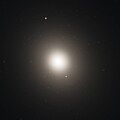Datei:M105.jpg
Zur Navigation springen
Zur Suche springen

Größe dieser Vorschau: 600 × 600 Pixel. Weitere Auflösungen: 240 × 240 Pixel | 480 × 480 Pixel | 985 × 985 Pixel
Originaldatei (985 × 985 Pixel, Dateigröße: 38 KB, MIME-Typ: image/jpeg)
Dateiversionen
Klicke auf einen Zeitpunkt, um diese Version zu laden.
| Version vom | Vorschaubild | Maße | Benutzer | Kommentar | |
|---|---|---|---|---|---|
| aktuell | 15:37, 22. Okt. 2017 |  | 985 × 985 (38 KB) | Fabian RRRR | {{Information |Description=Messier 105 M105 (aka NGC 3379) - Hubble peered into the core of M105 (also known as NGC 3379) and measured the motions of stars swirling around its center. These observations proved that a supermassive black hole resides at... |
Dateiverwendung
Die folgende Seite verwendet diese Datei:
Globale Dateiverwendung
Die nachfolgenden anderen Wikis verwenden diese Datei:
- Verwendung auf pl.wikipedia.org
- Verwendung auf ru.wikipedia.org
- Verwendung auf sv.wikipedia.org
- Verwendung auf th.wikipedia.org